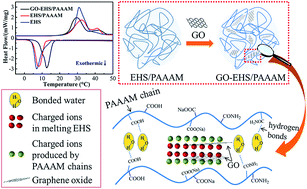Graphene oxide modified hydrate salt hydrogels: form-stable phase change materials for smart thermal management
Abstract
Advanced phase change materials (PCMs) with tunable phase transition behaviors are increasingly meaningful to the regulation and control of temperature in changeable application environments. This study presents a graphene oxide-modified hydrate salt/poly(acrylamide-co-acrylic acid) copolymer hydrogel (GO-EHS/PAAAM) form-stable phase change composite wherein the phase transition behaviors of the hydrate salt PCM could be tailored through the special interaction of GO and PAAAM with the hydrate salt. The DSC results described that the peak shape during the endothermic process was converted from the single peak of a pure hydrate salt into two interconnected peaks from the GO-EHS/PAAAM composite, of which the mechanistic analysis was validated via SEM, FT-IR and Raman spectroscopy. The thermal conductivity of GO-EHS/PAAAM with 2 wt% of GO increased by 54% when compared with EHS/PAAAM. Moreover, the GO-EHS/PAAAM composite remained chemically and thermally stable after 300 thermal cycles. The obtained results suggested that GO-EHS/PAAAM composites were a promising route for achieving adjustable phase transition behavior targets of the hydrate salt PCMs used for smart thermal management.


 Please wait while we load your content...
Please wait while we load your content...